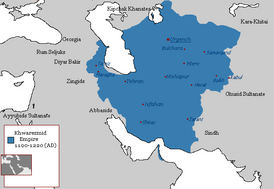Хоразмшоҳиён
Хонадони Анӯштекин (форсӣ: خاندان انوشتکین) ё Хоразмшоҳиён (форсӣ: خوارزمشاهیان) — дудмоне турктабор бо фарҳанги туркӣ-эронӣ[1][2][3] ва суннимазҳаб буд, ки ғуломон турк онро бино ниҳоданд[4][5] ва бар Эрону Осиёи Миёна ҳоким буданд.
| Парчам | |
 | |
| Таърихи таъсис | 1077 |
|---|---|
 | |
| Унвон | Khwarazmshah[d] |
| Бунёнгузор | Анӯштегин |
| Қитъа | Осиё |
| Кишвар | |
| Забони мавриди корбурд | забонҳои эронии шарқӣ |
| Замони поён | 1260 |
Хоразмшоҳиён ибтидо ба унвони ҳукумате дастнишонда аз тарафи Салтанати Салҷуқӣ буда ва баъд аз он ба сурати подшоҳии мустақил ҳукумат карданд[6]. Бунёнгузори ин силсила, Анӯштегин буд, ки дар соли 1077 Маликшоҳи Салҷуқӣ ӯро ба унвони шаҳна ва ҳокими Хоразм мансуб кард. Фарзандони Анӯштекин (то пеш аз соли 1157) ба намояндагӣ аз подшоҳони салҷуқӣ бар Хоразм ҳукмронӣ мекарданд.
Эзоҳ
вироиш- ↑ C. E. Bosworth: Khwarazmshahs i. Descendants of the line of Anuštigin. In Encyclopaedia Iranica, online ed., 2009: "Little specific is known about the internal functioning of the Khwarazmian state, but its bureaucracy, directed as it was by Persian officials, must have followed the Saljuq model. This is the impression gained from the various Khwarazmian chancery and financial documents preserved in the collections of enšāʾdocuments and epistles from this period. The authors of at least three of these collections—Rašid-al-Din Vaṭvāṭ (d. 1182-83 or 1187-88), with his two collections of rasāʾel, and Bahāʾ-al-Din Baḡdādi, compiler of the important Ketāb al-tawaṣṣol elā al-tarassol—were heads of the Khwarazmian chancery. The Khwarazmshahs had viziers as their chief executives, on the traditional pattern, and only as the dynasty approached its end did ʿAlāʾ-al-Din Moḥammad in ca. 615/1218 divide up the office amongst six commissioners (wakildārs; see Kafesoğlu, pp. 5-8, 17; Horst, pp. 10-12, 25, and passim). Nor is much specifically known of court life in Gorgānj under the Khwarazmshahs, but they had, like other rulers of their age, their court eulogists, and as well as being a noted stylist, Rašid-al-Din Vaṭvāṭ also had a considerable reputation as a poet in Persian."
- ↑ Homa Katouzian, "Iranian history and politics", Published by Routledge, 2003. pg 128: "Indeed, since the formation of the Ghaznavids state in the tenth century until the fall of Qajars at the beginning of the twentieth century, most parts of the Iranian cultural regions were ruled by Turkic-speaking dynasties most of the time. At the same time, the official language was Persian, the court literature was in Persian, and most of the chancellors, ministers, and mandarins were Persian speakers of the highest learning and ability"
- ↑ "Persian Prose Literature." World Eras. 2002. HighBeam Research. (3 September 2012);"Princes, although they were often tutored in Arabic and religious subjects, frequently did not feel as comfortable with the Arabic language and preferred literature in Persian, which was either their mother tongue—as in the case of dynasties such as the Saffarids (861–1003), Samanids (873–1005), and Buyids (945–1055)—or was a preferred lingua franca for them—as with the later Turkish dynasties such as the Ghaznawids (977–1187) and Saljuks (1037–1194)". [1]
- ↑ Bosworth in Camb. Hist. of Iran, Vol. V, pp. 66 & 93; B.G. Gafurov & D. Kaushik, "Central Asia: Pre-Historic to Pre-Modern Times"; Delhi, 2005; ISBN 81-7541-246-1
- ↑ C. E. Bosworth, "Chorasmia ii. In Islamic times" in: Encyclopaedia Iranica (reference to Turkish scholar Kafesoğlu), v, p. 140, Online Edition: "The governors were often Turkish slave commanders of the Saljuqs; one of them was Anūštigin Ḡaṛčaʾī, whose son Qoṭb-al-Dīn Moḥammad began in 490/1097 what became in effect a hereditary and largely independent line of ḵǰᵛārazmšāhs." (LINK)
- ↑ Rene Grousset, The Empire of the Steppes:A History of Central Asia, Transl. Naomi Walford, (Rutgers University Press, 1991), 159.